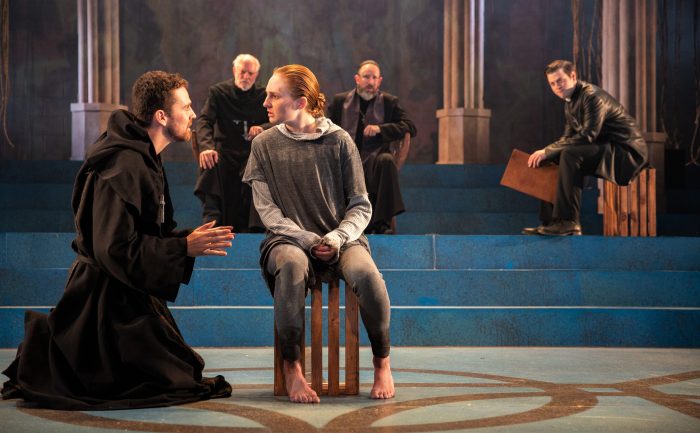
Saint Joan by George Bernard Shaw, a new version with additional scenes by Chelsea Marcantel. Bud Martin directs at Delaware Theater Company, Wilmington Delaware through February 24, 2019.
This stunning new production emphasizes the feminist strength that George Bernard Shaw intentionally put into his 1923 play about the French teenager who was burned to death because she disrespected the religious and political leaders of 15th century France and England.
Chelsea Marcantel, upon commission by Bud Martin of the Delaware Theater, updated the text by adding female characters and two new scenes (while trimming some of Shaw’s words) but she changed none of Shaw’s thrust. The Irish playwright wanted to emphasize the way in which “she was judicially burnt essentially for what we call unwomanly and insufferable presumption.”
He went on to write, “If she had been old enough to know the effect she was producing on the men whom she humiliated by being right when they were wrong, and had learned to flatter and manage them, she might have lived as long as Queen Elizabeth.” He was referring, of course, to the first Queen Elizabeth who lived to age 69.
Shaw chose to avoid villains in the drama. The powerful men who condemn Joan to death have understandable fears and intentions. The clerics are offended that this woman has a back-channel to God. Meanwhile, Joan is pictured as a simple girl, not sanctimonious. Audience members may be non-religious and still relate to her feelings that God was calling her to a necessary mission.
Shaw, not particularly religious, posited that Joan had moral convictions and a strong intuition of right and wrong, and she interpreted her feelings as being a message from God. Shaw’s text has her speak about seeing visions of Saint Catherine and Saint Margaret, who were teenaged Catholic martyrs from earlier times. This production gives those spirits form. They appear on stage; we see them although Joan’s adversaries do not. Their voices have some electronic reverberation to suggest their other-wordliness.
This play has resonance to America today, where some men are angered by the impatience of women who have not been respected. As Shaw wrote, “When she was thwarted by men whom she thought fools, she made no secret of her opinion of them or her impatience with their folly; and she was naïve enough to expect them to be obliged to her for setting them right.”
Another fascination in this production by Bud Martin is the distribution of more than twenty roles among eight superb actors. It’s fun to see players like Charlie Delmarcelle exit stage left, then make a fast turnaround and re-emerge with an entirely different posture and persona. Michael Doherty, especially, creates vivid characterizations of opposite types. He’s a deliciously fey and spineless Charles the Dauphin, then becomes fierce as Prosecutor D’Estivet.
Dan Kern is distinguished as he plays the Archbishop of Rheims, the Inquisitor and a Messenger from the future. Mary Martello is conniving as she plays Lady Warwick and other roles. Her Lady is a change from the original, where Shaw had a man, the Earl of Warwick, demand the execution of Joan. (Henry V gave Warwick the responsibility for the education of the infant King Henry VI, and Warwick believes that Joan wants to create a system in which the king is responsible to God alone, which would strip him and other feudal lords of their power.)
Clare O’Malley is radiant as Joan, with simplicity and modesty. Mary Tuomanen and Tai Verley are excellent as her saintly companions. Sean Michael Bradley is sturdy in other parts.
To describe the action briefly, a plain French teenage farm girl comes to Robert, squire of Baudricourt castle, and says, “You are to give me a horse and armor and some soldiers, and send me to the Dauphin. The Dauphin will give me all I need to raise the siege of Orleans. That is what God is sending me to do.”
Robert is disbelieving, and so is the archbishop who says, “She is not even a respectable woman. She does not wear women’s clothes.” Eventually Joan gets to see the Dauphin, aged 26, really King Charles the Seventh since the death of his father but as yet uncrowned. He’s a humorous nincompoop, but Joan leads an army that drives out the English and Charles is invested as king in the Cathedral of Rheims.
Disregarding warnings that she isn’t respectful to her superiors, Joan leads a further battle and loses to the English, who imprison her and put her on trial.
Colin McIlvaine’s design includes multiple levels, beaded curtains, a massive set and excellent projections of the soaring arches of France’s overbearing cathedrals by Nicholas Hussong and Joey Moro. Thom Weaver’s lighting simulates shafts of stained glass.
To sum up by paraphrasing Shaw, Joan of Arc’s combination of inept youth with courage, originality and oddity makes her an appealing subject, and this is a dramatic production with great heart.